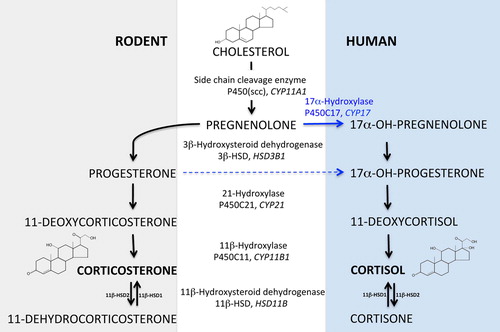Figures & data
Figure 1. The GC synthesis pathways in rodents and humans. The different metabolites in the synthesis of GC (corticosterone or cortisol) from cholesterol and the enzymes involved in specific steps are indicated.

Figure 2. Ex vivo GC synthesis (ng/g tissue) under steady-state conditions and after inflammation triggering through LPS injection. C57B/6 mice were either treated i.p. with 100 μg LPS or left untreated to avoid stress. Three hours later the mice were sacrificed, organs were taken for ex vivo culture, and blood was taken through cardiac puncture to measure serum corticosterone levels. Organs were chopped into small pieces and rinsed with ice-cold PBS, containing 2% horse serum, then cultured for 4 h in medium supplemented with charcoal-stripped 5% horse serum. The adrenals were incubated for 3 h only. Each organ was cultured in duplicates with and without the steroidogenesis inhibitor metyrapone. Corticosterone concentration in the supernatant was measured by radioimmunoassay. Data are presented as the metyrapone blockable corticosterone fraction, i.e. locally synthesized GC. n = 3 mice for all organs, except adrenals.

Figure 3. GC sources and their presumable regulation in the organism. 11βHDR = 11β-hydroxylase; 11βHSD = 11β-hydroxysteroid dehydrogenase; ACTH = adrenocorticotropic hormone; F.X = unknown factor; GC = glucocorticoids; LRH-1 = liver receptor homolog 1; SF-1 = steroidogenic factor 1; TNFα = tumor necrosis factor alpha. Transcription factors are presented in italic, and steroidogenic enzymes are underlined.

